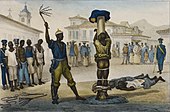| Part of a series on |
| Corporal punishment |
|---|
 |
| By place |
| By implementation |
| By country |
| Court cases |
| Politics |
| Campaigns against corporal punishment |
Caning is used as a form of corporal punishment in Malaysia. It can be divided into at least four contexts: judicial/prison, school, domestic, and sharia/syariah. Of these, the first is largely a legacy of British colonial rule in the territories that are now part of Malaysia, particularly Malaya.[1]
Judicial caning, the most severe of the four forms of corporal punishment in Malaysia, can be ordered as part of a criminal sentence imposed by civil courts on male convicts. Always ordered in addition to a prison sentence for adult offenders, it is inflicted with a long and thick rattan cane on the prisoner's bare buttocks in an enclosed area in the prison. Convicts who were not sentenced to caning earlier in a court of law may also be punished by caning in the same way if they commit aggravated offences while serving time in prison.
In schools, students may be caned with a light rattan cane on the buttocks over clothing or the palm of the hand for serious misconduct. Although legally only boys can be caned, the caning of girls is common in Malaysia. In the domestic setting, it is legally and culturally acceptable for parents to punish their children with a light rattan cane for misbehaviour. Sharia courts can sentence Muslim men and women (including Muslim foreigners) to caning for committing certain offences. This form of caning is much less severe compared to judicial caning and it is designed to humiliate the offender rather than to inflict physical pain.
Malaysia has been criticised by human rights groups for its use of judicial caning, which Amnesty International claims "subjects thousands of people each year to systematic torture and ill-treatment, leaving them with permanent physical and psychological scars".[2]
- ^ "Judicial Caning in Singapore, Malaysia and Brunei #The History of Caning in Singapore, Malaysia and Brunei". World Corporal Punishment Research. January 2019. Retrieved 25 June 2019.
- ^ "Malaysia: Torture practiced systematically in widespread caning". Amnesty International. 6 December 2010. Retrieved 30 January 2015.